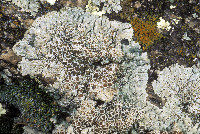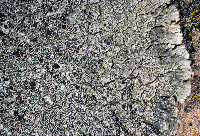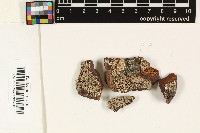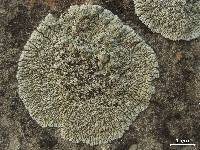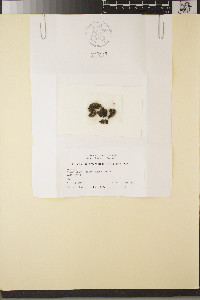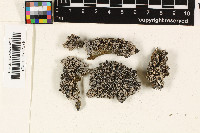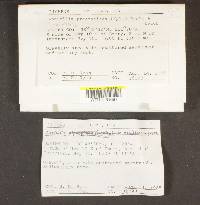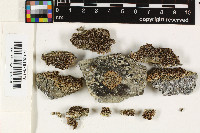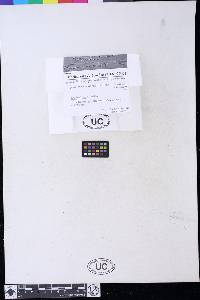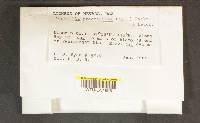Lobothallia praeradiosa
|
|
|
|
Family: Megasporaceae
[Aspicilia praeradiosa (Nyl.) Poelt & Leuckert, moreLecanora bogdoënsis Tomin, Lecanora praeradiosa Nyl., Lecanora praeradiosa f. csikensis (Gyeln.) Zahlbr., Lecanora praeradiosa f. melanocarpa Gyeln., Lecanora praeradiosa f. praeradiosa Nyl., Lecanora praeradiosa var. budensis Gyeln., Lecanora praeradiosa var. praeradiosa Nyl., Placodium praeradiosum (Nyl.) Szatala, Placolecanora bogdoënsis (Tomin) Kopach., Placolecanora praeradiosa (Nyl.) Sedeln., Squamaria praeradiosa (Nyl.) H. Olivier, Squamaria praeradiosa f. csikensis Gyeln., Squamaria praeradiosa f. farkasvolgyensis Gyeln., Squamaria praeradiosa f. matyashegyensis Gyeln., Squamaria praeradiosa f. nyekensis Gyeln., Squamaria praeradiosa f. praeradiosa (Nyl.) H. Olivier, Squamaria praeradiosa f. sashegyensis Gyeln.] |
Nash, T.H., Ryan, B.D., Gries, C., Bungartz, F., (eds.) 2004. Lichen Flora of the Greater Sonoran Desert Region. Vol 2. Thallus: placodioid, up to 0.5-1 mm thick centrally, +tightly attached (not removable intact), areolate to areolate-granulose or verrucose-areolate, typically forming distinct rosettes, but often very irregular areoles: contiguous to +scattered or densely imbricate, 0.5-1 mm wide, plane to convex, becoming crenate-lobed lobes: contiguous but +discrete, typically radiating, +linear and closely attached, but often irregularly arranged, short, and rather loosely attached, sometimes imbricated, plane slightly convex (never terete nor swollen, up to 3-5 mm long, 0.5-1 mm wide, 0.25-0.5 mm thick, towards tips partly broadened or slightly revolute upper surface: yellowish white or brownish gray, reddish gray, gray, gray-white to pale grayish brown or (especially in North American material) yellow-brown, towards the periphery more yellow or sometimes olive-gray, unchanged color when wet, smooth, usually epruinose (to densely pruinose on limestone), weakly maculate upper cortex: phenocortical, but with few or no dead algal cells, diffuse brown, usually inspersed with abundant fine, dark granules (soluble in K), or (where pruinose) not inspersed but with surface layer of abundant coarse, hyaline granules and plate-like crystals (both insoluble in K); hyphae: anticlinal to unoriented; epinecral layer: present medulla: +loose (thallus often crumbling when sectioned) but solid; hyphae: +anticlinal; without hyphal bundles, with fine and coarse hyaline granules and coarse plate-like crystals (all insoluble in K); algal layer: very unevenly thickened, up to c. 75 µm thick; algae grouped to scattered, below upper cortex lower cortex: absent, or paraplectenchymatous lower surface: usually not visible except near lobe tips, pale Apothecia: numerous, +round, up to 1-2 mm in diam., not becoming compound or confluent, adnate to appressed-sessile, usually soon distinctly sessile and sometimes constricted at the base disc: pale testaceous or brown to black, or often yellowish to reddish brown; plane or commonly convex, epruinose, dull to +shiny, to +blue-white pruinose at least toward center, margin: often +raised when young, 0.1(-0.3) mm wide, entire to flexuous or crenate, persistent, in section appearing +swollen; parathecial crown: often present, dark cortex: continuous with that of thallus, eucortical, paraplectenchymatous, usually with +abundant dark brown crystals (soluble in K), often with surface layer of coarse hyaline granules (usually insoluble in K), or (when pruinose) also abundant, coarse plate-like crystals (insoluble in K); hyphae: moderately swollen; algae: scattered to grouped, in margin and below hypothecium; medulla: with abundant coarse, hyaline, plate-like crystals (insoluble in K) epihymenium: diffuse pale brown, 10-15(-30) µm thick, usually inspersed with abundant fine dark red-brown granules (pigment and granules usually +insoluble in K) and covered by layer of coarse hyaline granules (+insoluble in K), or (in material with rather bright yellowish- to reddish-brown discs) pigment and granules soluble in K and with distinct, non-granular hyaline surface layer hymenium: hyaline, 70-80 µm tall; paraphyses: upper 3-4 cells often +short and swollen (submonilliform); apical cells: +short-clavate 2-3 µm wide, hyaline or (in material with pruinose thallus and/or dull, +pruinose discs) brown-walled; hypothecium: 50-60 µm thick asci: oblong-elipsoid, 60-75 x 20 µm ascospores: hyaline, simple, ellipsoid to ovoid, or often subglobose to broadly ellipsoid, (8-)9-13(-14) x 7-9.5 µm Spot tests: thallus and apothecia C-, KC-; cortex K+ yellow then red, P+ orange, or (in some variants) sometimes K-, P-; medulla K+ red, P+ orange Secondary metabolites: norstictic and constictic acids (9'-O-methylsalazinic acid). Substrate and ecology: on siliceous rocks (e.g., volcanic rocks, granite, rhyolite, basalt, sandstone) exposed to or containing some calcium, in dry, very sunny sites; also on silicate-carbonate rocks (silica content almost equal to that of calcium or magnesium), occasionally on limestone World distribution: southern Europe, North Africa, central Asia, western North America, and Central America Sonoran distribution: Arizona, southern California, Baja California, Baja California Sur, and Chihuahua. Notes: Lobothallia praeradiosa is in many ways intermediate between L. alphoplaca and L. radiosa. (Poelt, pers. comm.). On the one hand, it shares many features with L. alphoplaca, not only in being K+ red but also in having more discrete to imbricate lobes, paler and more yellowish or reddish upper surface, cortices with abundant fine brown granules soluble in K, presence of an epinecral layer, rather loose medulla, soon sessile apothecia, plane to convex, separate (not compound or confluent) discs, and relatively large asci. On the other hand, it is similar to L. radiosa in having a thin, closely adnate thallus, +flattened lobes, phenocortex in the thallus, algae restricted to groups below the upper cortex, absence of hyphal bundles in the medulla, relatively small apothecia, narrow and hyaline paraphyses tips, and rather small spores. Pale forms of L. praeradiosa can be mistaken for lobed species of Lecanora, such as L. muralis, which contain usnic acid and (at least in our area) are K-. Although Eigler (1969) states that the hypothecium and ascogenous layer of L. praeradiosa are often rather strong diffuse red-brown, in the material I have examined (including two Eurasian specimens), the hypothecium is hyaline and the ascogenous layer is at most weakly gray, yellow, or brown. As delimited here in a broad sense, L. praeradiosa includes, in addition to the +typical morphotype and chemotype, several main variations. It is beyond the scope of the present treatment to further analyze these variations, but in general material from the Sonoran region (and elsewhere in North America) frequently differs from typical Eurasian material in such characters as development of the lobes (often short, irregular, and rather loosely attached), pruinosity of the thallus and/or apothecia (both often pruinose), color of the thallus (most often yellow to yellowish brown or orange-yellow), color of the discs (often rather bright yellowish- to reddish-brown), conspicuousness of the parathecial crown, and K reaction of the cortex (sometimes K-). Some of these variations appear to correlate with anatomical characters (especially presence and distribution of various types of granules or crystals, and pigmentation of the paraphyses tips) and may represent distinct taxa at the specific or infraspecific level. |
|
|
|



